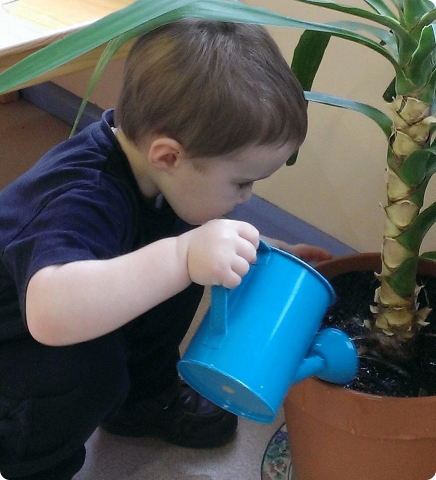Growing Independence
Growing Independence
Independence is the ability to do things for ourselves and think for ourselves. Children become independent through direct experience of their own capabilities. This comes through being included in simple daily activities. Offering young children appropriate choices and only lending a hand when they really need help, communicates to them that we believe that they can do this by themselves. Having the opportunity to have a go, make mistakes and try again and again, builds your child's skills, confidence, and an "I can do it" attitude.
Very young children have surprising capabilities and can develop their independence in the following areas:
Dressing
- Some items of clothing will be easier for your child to take on and off independently than others. Choosing clothes based on how easily your child will be able to put them on and take them off, will increase their success in dressing and undressing themselves. You could think about offering shirts which easily pull over their head; pants with an elastic waist; velcro fastenings on shoes and snap fastenings on outdoor clothing.
- Very young children will enjoy deciding between two choices of clothing. Older children will enjoy having a third choice and then ultimately making their own independent choice. When we don't offer a choice, your child might take the alternative option, which is 'No!".
- Hanging up the choice of clothing on a low bar at your child'd height will mean that they can make the choice at their own pace.
- Placing a child-sized basket in your child's space for dirty clothes will increase their chances of being successful at handling their dirty clothing.
- A low mirror, along with a hairbrush, face washer and toothbrush placed at your child's height will make it easy for your child to look after themselves.
Eating
- Setting things up in your kitchen so that your child has access to drinking glasses, a water jug, bowls, plates, spoons and forks (in a container) is really quite simple. It doesn't always occur to us to do it, particularly if we didn't experience this as children ourselves. You could empty a low kitchen cabinet and dedicate it to your child's needs for accessing water and food.
- It really supports your child to have crockery and cultery designed to be used by their smal hands. Providing breakable materials rather than plastic, enables your child to learn how to handle objects with care. There might be 1 or 2 breakages in the beginning, but children learn quickly how to avoid this given the opportunity.
- Providing simple food preparation tasks such as spreading crackers, pealing a hard boiled egg or slicing a banana will increase your child's interest in these foods.
Sleeping
- Providing your child with a low bed from the beginning will give them the freedom to move around. It will also allow them to wake up and crawl off the bed in the morning. You could place a low shelf with 2 or 3 toys on each shelf designed to catch their attention when they wake up.
- A regular bed time routine will provide your child with a sense of security at the end of the day. They will be able to anticipate what is coming next and prepare. The elements of the routine will be different for every family, but is makes sense to ensure that it is one of diminishing activity e.g. play time, bath time, story time, sleep time.
Toileting
- Offering your child a potty whilst they are learning how to use the toilet will ensure that they feel secure when manoeuvering and sitting to toilet. Once your child is able to climb one or two stairs independently and has learnt how to toilet in the potty, you could provide a wide stool which they can easily turn around on to sit on the family toilet.
- A stool for accessing the sink for hand-washing and tooth-brushing will enable your child to reach the taps independently. They can also use this as a low seat for changing their underpants.
You can find more information about supporting your child's growing independence here

